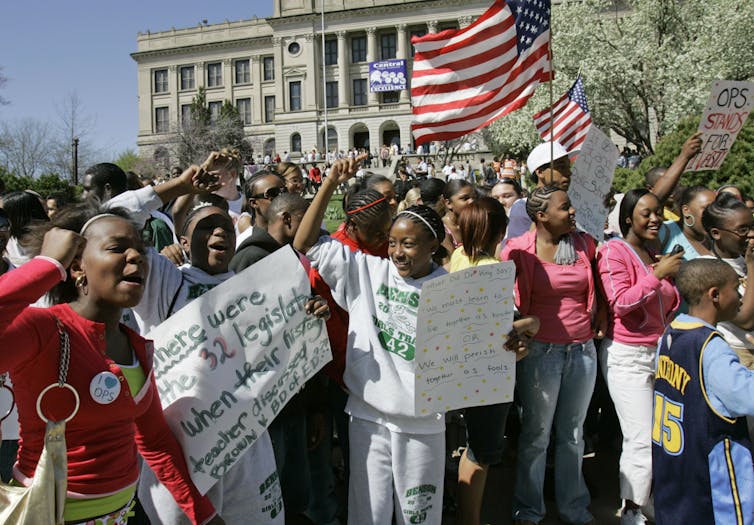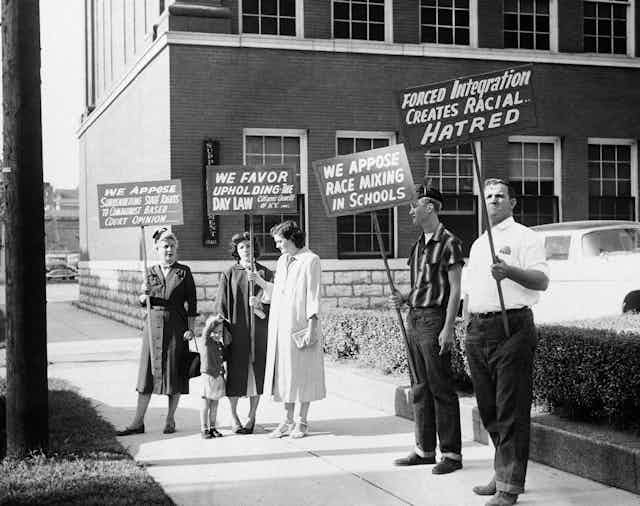A federal district court judge has decided that Gardendale – a predominantly white city in the suburbs of Birmingham, Alabama – can move forward in its effort to secede from the school district that serves the larger county. The district Gardendale is leaving is 48 percent black and 44 percent white. The new district would be almost all white.
The idea that a judge could allow this is unfathomable to most, but the case demonstrates in the most stark terms that school segregation is still with us. While racial segregation in U.S. schools plummeted between the late 1960s and 1980, it has steadily increased ever since – to the the point that schools are about as segregated today as they were 50 years ago.
As a former school desegregation lawyer and now a scholar of educational inequality and law, I have both witnessed and researched an odd shift to a new kind of segregation that somehow seems socially acceptable. So long as it operates with some semblance of furthering educational quality or school choice, even a federal district court is willing to sanction it.
While proponents of the secession claim they just want the best education for their children and opponents decry the secession as old-school racism, the truth is more complex: Race, education and school quality are inextricably intertwined.
Rationalizing Gardendale’s segregation
In some respects, Gardendale is no different from many other communities.
Thirty-seven percent of our public schools are basically one-race schools – nearly all white or all minority. In New York, two out of three black students attend a school that is 90 to 100 percent minority.

In many areas, this racial isolation has occurred gradually over time, and is often written off as the result of demographic shifts and private preferences that are beyond a school district’s control.
The Gardendale parents argued their motivations were not about race at all, but just ensuring their kids had access to good schools. The evidence pointed in the other direction: In language rarely offered by modern courts, the judge found, at the heart of the secession, “a desire to control the racial demographics of [its] public schools” by “eliminat[ing]… black students [from] Gardendale schools.”
Still, these findings were not enough to stop the secession. As in many other cases over the past two decades, the judge conceded to resegregation, speculating that if she stopped the move, innocent parties would suffer: Black students who stayed in Gardendale would be made to feel unwelcome and those legitimately seeking educational improvements would be stymied.
Simply put, the judge could not find an upside to blocking secessionists whom she herself characterized as racially motivated.
As such, the court held that Gardendale’s secession could move forward. Two of its elementary schools can secede now, while the remaining elementary and upper-level schools must do so gradually.
The problem with conceding to segregation
Unfortunately, there’s no middle ground in segregation cases. No matter what spin a court puts on it, allowing secessions like Gardendale’s hands racism a win.
While it’s true that stopping the secession may come with a cost to members of that community who have done nothing wrong, our Constitution demands that public institutions comply with the law. That is the price of living in a democracy that prizes principles over outcomes.

In this case, the constitutional principles are clear. In Brown v. Board of Education, the Supreme Court held that there is no such thing as separate but equal schools: Segregated schools are “inherently unequal.”
Rather than stick to these principles, the judge in the Gardendale case seemingly tried to strike a bargain with segregation. As long as Gardendale appoints “at least one African-American resident” to its school board and does not do anything overtly racist moving forward, the court will allow the city to pursue its own agenda.
The sordid roots of school quality – and inequality
The ruling in Gardendale is a step toward reinforcing an unfortunate status quo in Alabama.
Alabama is one of a handful of states that amended its state constitution in an attempt to avoid desegregation in the 1950s. The amendment gave parents the right to avoid sending their kids to integrated schools and made clear that the state was no longer obligated to fund public education. Alabama preferred an underfunded and optional educational system to an integrated one. Courts quickly struck down the discriminatory parts of the new constitution, but the poor state education system remained.
Today, student achievement in Alabama ranks dead last – or near it – on every measure. Most communities don’t have the resources to do anything about it. Funding is relatively low – and unequal from district to district. Even after adjusting for variations in regional costs, a recent study shows that the overwhelming majority of schools in Alabama are funded at ten percent or more below the national average and another substantial chunk is thirty-three percent or more below the national average.
Parents trapped in under-resourced schools understandably feel like they need to take action. But rather than demanding an effective and well-supported statewide system of public schools, parents with the means often feel compelled to isolate their children from the larger system that surrounds them.
And while whites and blacks struggle over the future of Gardendale’s schools, the real culprits – the current state legislature and the segregationists who gutted public education in Alabama decades ago – go unchallenged.

The path forward leads through equal public education
The education system in Alabama, like in so many other states, is rigged against a large percentage of families and communities: Those with less money tend to get a worse education. Until these states reform their overall education funding systems, the inequalities and inadequacies that they produce will continue to fuel current racial motivations.
The lawsuit in Gardendale was a poor vehicle for fixing Alabama’s education system: The state’s overall education system was not on trial. The only issue before the court was a racially motivated district line in one small community.
But our small communities are connected to larger education systems.
In my view, we cannot fix those systems by way of more individual choice, charters, vouchers or school district secessions. The fact is, educational funding is down across the board, when compared to a decade ago. If we want all students to have a decent shot at better education, we need to recommit to statewide systems of public education. Only then will our base fears and racial biases begin to fade into the background.

